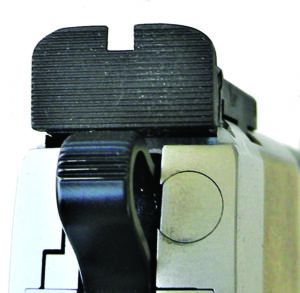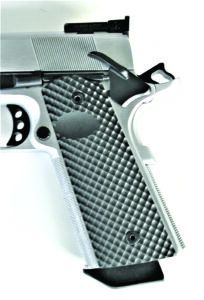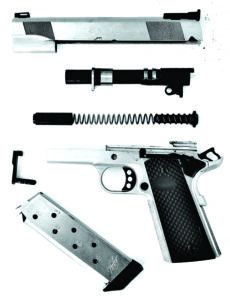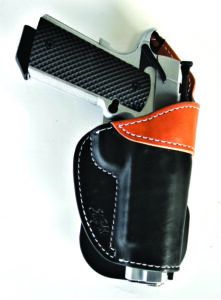After testing five high-end 1911 handguns in the July 2020 issue, we got four more guns to conduct an even greater and more demanding test of steel. The 1911 handgun has continued in service, even at the top of the heap, in competition and service use long after other mechanical designs have been out of service or relegated to the museum. A low bore axis, straight-to-the-rear trigger compression, a grip that fits most hands well, and a design that lends itself well to customization has the potential to suit every shooter. Among expensive 1911 handguns, the primary difference in the pistols isn’t the number of features, although self-luminous sights and extended controls have a bearing on price. Rather, the reason they are so expensive is the quality of machine work and manufacture. The trigger compression, barrel fit, and frame-to-slide fit are usually as good as human hands can make them, and the cosmetics are almost always top notch. Such guns will almost always be able to outshoot their owners, and their operation is flawlessly reliable.
All of the pistols tested are 5-inch-barrel steel-frame 1911 handguns. This means they are not difficult to control with full-power ammunition. Our contestants were:
- The Dan Wesson Specialist 01802 45 ACP, $1732. We found a Specialist “on sale” for $1575 and moved too late to obtain it, and we also located a few for $2020. It seems $1700 is about average. Our test gun cost us a bit more than the Springfield and a thousand dollars less than the Wilson Combat and Les Baer, on average. While the Dan Wesson may be a “production” pistol, unless the pistol is modified one at a time by a custom pistolsmith, most high-end 1911 handguns are products of a certain package or formula, so its factory SKU didn’t put us off one bit. The Dan Wesson Specialist is the heaviest 1911 tested at 43 ounces unloaded — just three ounces less than a 6-inch-barrel 357 Magnum Python.
- The Les Baer 572 Hemi 45 ACP, $2853. This pistol is named after Les Baer’s drag car. It is a distinctive pistol with a chrome finish, black grips, and black Dupont S coated controls. Some of the raters were left cold by the color scheme, others were very enthusiastic, it is that type of pistol. The pistol features both standard and forward cocking serrations. They are nicely machined with a finer pattern than the other handguns.
- The Springfield Armory 1911 TRP PC9107L18 45 ACP, $1648. We found this pistol listed for $1299 at several outlets, but also saw it as out of stock. The Tactical Response Pistol is a factory-production 1911 turned out by the Springfield custom shop. You cannot upgrade a Loaded Model by gunsmithing it into a TRP; the TRP is a tighter gun. The frame is fitted to the slide, and the result is a very tight pistol — it seemed as tight as the Wilson Combat or Dan Wesson pistols.
- The Wilson Combat Close Quarters Battle 45 ACP, $2865. The Close Quarters Battle is the flagship combat pistol offered by Wilson Combat. The CQB is manufactured using the same parts you might order to build your own Wilson Combat pistol, save the parts fitted in house by Wilson Combat gunsmiths. A trademark of the CQB is excellent barrel fitting. The barrel-to-slide and bushing fit are tight, and the barrel crown is well done. This pistol’s steel frame and slide have an Armor Tuff coating that is evenly applied and seems durable, we thought.

These are four different handguns with different downrange performance, but the bottom line connecting them is reliability. To check for this, we fired the 80 rounds of ammunition on the combat course, mixing up the lot with mostly practice loads, 40 rounds of Black Hills Ammunition 200-grain LSWCs, 20 rounds of Fiocchi 230-grain FMJs, and 20 rounds of a handload consisting of the Hornady 230-grain XTPs over enough Titegroup powder for 855 fps.
Among the guns, the Les Baer 572 Hemi is primarily designed for extreme accuracy. The Wilson Combat CQB is a formidable defensive firearm. The Dan Wesson Specialist is for service use. The Springfield Tactical Response pistol is intended to offer excellent performance, but it isn’t as expensive as the Springfield Professional, which is an FBI SWAT pistol, and it was deemed a good match on the lower end of high-end prices.
Gun Tests Grade: A
$2853
A Les Baer pistol often requires a break-in period, according to conventional wisdom and the maker. This is the second new Les Baer we have tested that came out of the box running, after having its long bearing surfaces lubricated. A pistol tested several years ago demanded a brief break in.
| Action Type | single action, short recoil-operated locked breech |
| Overall Length | 8.6 in. |
| Overall Height | 5.5 in. |
| Maximum Width | 1.25 in. |
| Weight Unloaded | 39.0 oz. |
| Weight Loaded | 44.0 oz. |
| Slide Material | Forged steel |
| Slide Retraction Effort | 20.0 lbs. |
| Receiver Material | Stainless steel |
| Finish | Stainless steel |
| Front Strap Height | 2.6 in. |
| Back Strap Height | 3.2 in. |
| Barrel Length | 5.0 in. |
| Grip Thickness Maximum | 1.25 in. |
| Grip Circumference | 5.2 in. |
| Magazines | Two 8-round |
| Rear Sight | Fully adjustable |
| Front Sight | Dovetailed post with fiber optic insert |
| Sight Radius | 6.5 in. |
| Trigger Pull Weight | 3.8 lbs. |
| Trigger Span | 2.8 in. |
| Safeties | Slide lock, grip |
| Warranty | None Written |
| Telephone | (563) 289-2126 |
| Website | LesBaer.com |
| Made In | U.S.A. |

The Les Baer rear sight was the only adjustable model among the test pistols. We have come a long way since the Bo-Mar, long out of production, was the only reliable and rugged automatic pistol rear sight assembly. The Les Baer sight offers a high degree of adjustment. The rear sight face is serrated. It is a low-mount sight, an important consideration. The front sight features a green-fiber-optic insert. Spare red- and green-fiber-optic rods are included in a plain cardboard box, along with two magazines.
The rear mainspring housing is checkered at 20 lines per square inch. The front strap is checkered in a secure 30 lpi that was never uncomfortable. The grips are VZ Recon models secured by hex-head screws. The pistol is hard chromed, and the slide-stop, ambi safety, magazine lock, hammer, trigger, and plunger tube, and small internals are finished in Dupont S coating. The bevel at the base of the magazine well helps in loading a magazine quickly. The hard-chrome finish, according to Les Baer, is 89 HC hardness, a hard coating indeed.

Some liked the VZ grips better than others. This is an aggressive pattern with the balance of adhesion and abrasion leaning toward abrasion. G10 is a thermoset plastic laminate with layers of woven fiberglass used in combination with an epoxy resin binder to create a strong and tacky grip surface. It isn’t for everyone. The controls are tight and crisp. Notably, the ambidextrous slide-lock safety is crisp when moved to the Safe position, but more difficult to move to the Fire position. Les Baer makes these adjustments so to prevent the shooter from thumbing the safety on during recoil, fast shooting strings, or movement. The slide is tight, very tight, requiring considerable effort to rack the slide. This isn’t because of the weight of the recoil spring but because of very tight slide-to-frame fit.
The best part of the pistol is the trigger. Trigger compression is a smooth 3.8 pounds with little take up and no trace of creep. When fired, there was a rapid reset without backlash.

We loaded both Les Baer and Wilson Combat magazines and headed to the firing line. During the combat firing test, we drew the pistol from a Wright Leatherworks paddle holster. We feel that speed to an accurate first shot is part of the test. There were no failures to feed, chamber, fire, or eject. The pistol demonstrated good-to-excellent combat accuracy. The heavier jacketed bullet loads were controllable, and combat accuracy looked good on the paper.
Moving to benchrest accuracy, we used three loads. These included the Black Hills Ammunition 230-grain JHP, the Fiocchi 230-grain FMJ, and a handload using the Hornady 185 XTP bullet and Titegroup powder for 1100 fps, a +P loading. Results were excellent. One of the best groups fired at 25 yards included four shots into 0.9 inch. The fifth bullet — wherever it was in the cadence of fire — opened the group to 1.5 inches. The smallest group was with the 185-grain handload, 1.25 inches. This is outstanding accuracy. The 3-inch guarantee for 50 yards should be met. The pistol was stable, with modest recoil.
Our Team Said: There were no problems of any type, and the pistol demonstrates excellent combat accuracy and practical accuracy. The ability to dial in the sights for the chosen load is an advantage. Racking the slide of this very tight gun was difficult for some.
45 ACP Range Data
All groups were fired at 25 yards from a benchrest position using a MTM Caseguard K Zone pistol rest. We used a Competition Electronics Pro Chrony to measure velocity. The first screen of the chronograph was 10 feet from the muzzle.| Black Hills 230-grain JHP | Les Baer Hemi 572 | Wilson Combat CQB | Dan Wesson Specialist | Springfield TRP |
| Average Velocity | 870 fps | 855 fps | 861 fps | 863 fps |
| Muzzle Energy | 387 ft.-lbs. | 373 ft.-lbs. | 379 ft.-lbs. | 380 ft.-lbs. |
| Small Group | 0.9 in. | 1.5 in. | 1.8 in. | 2.0 in. |
| Average Group | 1.5 in. | 1.9 in. | 2.3 in. | 2.6 in. |
| Fiocchi 230-grain JHP | Les Baer Hemi 572 | Wilson Combat CQB | Dan Wesson Specialist | Springfield TRP |
| Average Velocity | 842 fps | 853 fps | 839 fps | 840 fps |
| Muzzle Energy | 362 ft.-lbs. | 372 ft.-lbs. | 359 ft.-lbs. | 360 ft.-lbs. |
| Small Group | 2.2 in. | 2.3 in. | 2.4 in. | 2.7 in. |
| Average Group | 2.6 in. | 2.6 in. | 2.8 in. | 3.0 in. |
| Handload Hornady 185-grain XTP | Les Baer Hemi 572 | Wilson Combat CQB | Dan Wesson Specialist | Springfield TRP |
| Average Velocity | 1125 fps | 1160 fps | 1140 fps | 1137 fps |
| Muzzle Energy | 520 ft.-lbs. | 553 ft.-lbs. | 534 ft.-lbs. | 531 ft.-lbs. |
| Small group | 1.3 in. | 1.4 in. | 1.9 in. | 1.7 in. |
| Average Group | 1.6 in. | 1.8 in. | 2.2 in. | 2.0 in. |


























Love the mag, keep up the good work.